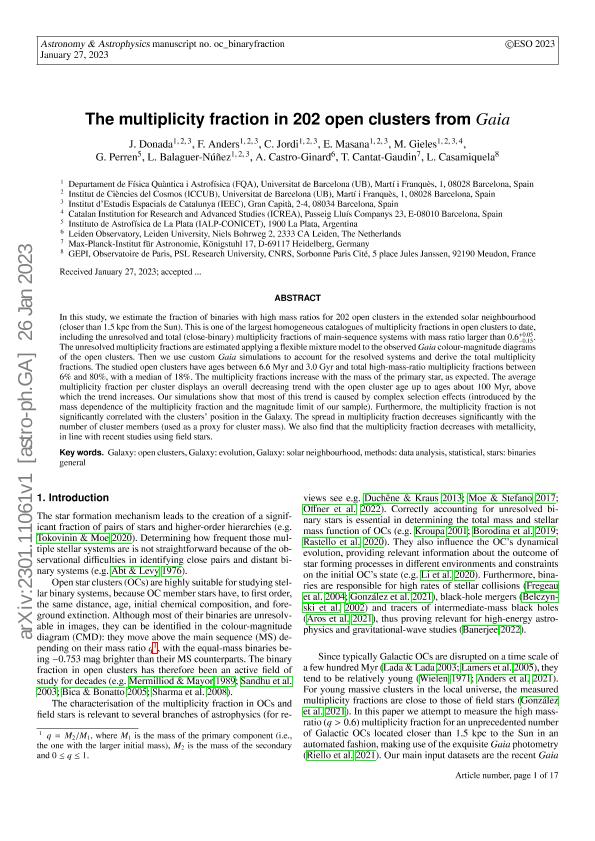Mostrar el registro sencillo del ítem
dc.contributor.author
Donada, J.
dc.contributor.author
Anders, F.
dc.contributor.author
Jordi, C.
dc.contributor.author
Masana, E.
dc.contributor.author
Gieles, M.
dc.contributor.author
Perren, Gabriel Ignacio

dc.contributor.author
Balaguer Núñez, L.
dc.contributor.author
Castro Ginard, A.
dc.contributor.author
Cantat Gaudin, T.
dc.contributor.author
Casamiquela, L.
dc.date.available
2024-04-26T14:55:54Z
dc.date.issued
2023-01
dc.identifier.citation
Donada, J.; Anders, F.; Jordi, C.; Masana, E.; Gieles, M.; et al.; The multiplicity fraction in 202 open clusters from Gaia; EDP Sciences; Astronomy and Astrophysics; 675; A89; 1-2023; 1-17
dc.identifier.issn
0004-6361
dc.identifier.uri
http://hdl.handle.net/11336/234102
dc.description.abstract
In this study, we estimate the fraction of binaries with high mass ratios for 202 open clusters in the extended solar neighbourhood (closer than 1.5 kpc from the Sun). This is one of the largest homogeneous catalogues of multiplicity fractions in open clusters to date, including the unresolved and total (close-binary) multiplicity fractions of main-sequence systems with mass ratio larger than 0.6+0.05−0.15. The unresolved multiplicity fractions are estimated applying a flexible mixture model to the observed Gaia colour-magnitude diagrams of the open clusters. Then we use custom Gaia simulations to account for the resolved systems and derive the total multiplicity fractions. The studied open clusters have ages between 6.6 Myr and 3.0 Gyr and total high-mass-ratio multiplicity fractions between 6% and 80%, with a median of 18%. The multiplicity fractions increase with the mass of the primary star, as expected. The average multiplicity fraction per cluster displays an overall decreasing trend with the open cluster age up to ages about 100 Myr, above which the trend increases. Our simulations show that most of this trend is caused by complex selection effects (introduced by the mass dependence of the multiplicity fraction and the magnitude limit of our sample). Furthermore, the multiplicity fraction is not significantly correlated with the clusters´ position in the Galaxy. The spread in multiplicity fraction decreases significantly with the number of cluster members (used as a proxy for cluster mass). We also find that the multiplicity fraction decreases with metallicity, in line with recent studies using field stars.
dc.format
application/pdf
dc.language.iso
eng
dc.publisher
EDP Sciences

dc.rights
info:eu-repo/semantics/openAccess
dc.rights.uri
https://creativecommons.org/licenses/by-nc-sa/2.5/ar/
dc.subject
GALAXY
dc.subject
EVOLUTION
dc.subject
OPEN
dc.subject
CLUSTER
dc.subject.classification
Astronomía

dc.subject.classification
Ciencias Físicas

dc.subject.classification
CIENCIAS NATURALES Y EXACTAS

dc.title
The multiplicity fraction in 202 open clusters from Gaia
dc.type
info:eu-repo/semantics/article
dc.type
info:ar-repo/semantics/artículo
dc.type
info:eu-repo/semantics/publishedVersion
dc.date.updated
2024-04-17T12:28:40Z
dc.journal.volume
675
dc.journal.number
A89
dc.journal.pagination
1-17
dc.journal.pais
Francia

dc.journal.ciudad
Paris
dc.description.fil
Fil: Donada, J.. Departament de Física Quàntica I Astrofísica; España
dc.description.fil
Fil: Anders, F.. Departament de Física Quàntica I Astrofísica; España
dc.description.fil
Fil: Jordi, C.. Departament de Física Quàntica I Astrofísica; España
dc.description.fil
Fil: Masana, E.. Departament de Física Quàntica I Astrofísica; España
dc.description.fil
Fil: Gieles, M.. Departament de Física Quàntica I Astrofísica; España
dc.description.fil
Fil: Perren, Gabriel Ignacio. Consejo Nacional de Investigaciones Científicas y Técnicas. Centro Científico Tecnológico Conicet - La Plata. Instituto de Astrofísica La Plata. Universidad Nacional de La Plata. Facultad de Ciencias Astronómicas y Geofísicas. Instituto de Astrofísica La Plata; Argentina
dc.description.fil
Fil: Balaguer Núñez, L.. Departament de Física Quàntica I Astrofísica; España
dc.description.fil
Fil: Castro Ginard, A.. Leiden Observatory; Países Bajos
dc.description.fil
Fil: Cantat Gaudin, T.. Max-planck-institut Für Astronomie; Alemania
dc.description.fil
Fil: Casamiquela, L.. Centre National de la Recherche Scientifique. Observatoire de Paris; Francia
dc.journal.title
Astronomy and Astrophysics

dc.relation.alternativeid
info:eu-repo/semantics/altIdentifier/url/https://www.aanda.org/articles/aa/abs/2023/07/aa45219-22/aa45219-22.html
dc.relation.alternativeid
info:eu-repo/semantics/altIdentifier/doi/http://dx.doi.org/10.1051/0004-6361/202245219
Archivos asociados
